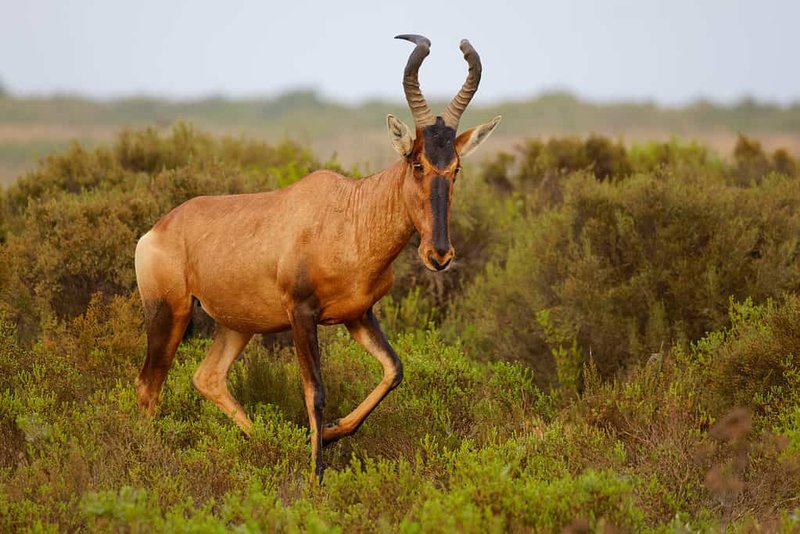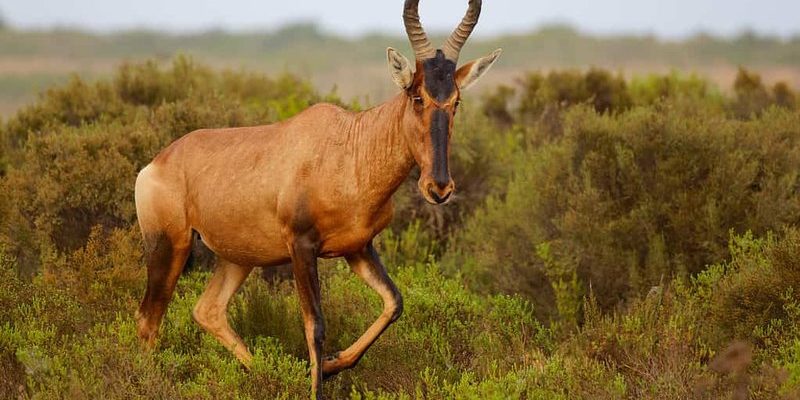
You see, the hartebeest is more than just a pretty face on the African plains. It’s a testament to nature’s ability to mold creatures to fit their surroundings perfectly. From its ancient ancestors to the various species we see today, the hartebeest’s story is one of resilience and adaptation.
Understanding the Hartebeest Family
The hartebeest belongs to the Bovidae family, which includes antelopes, gazelles, and cattle. Its scientific name, *Alcelaphus buselaphus*, is indicative of its close relationship with other members of the grazing herbivore community. There are several subspecies of hartebeest, each with its own unique adaptations.
These animals are primarily found in various habitats across eastern and southern Africa, including savannas, grasslands, and open woodlands. The common name “hartebeest” derives from the Dutch words for “hard beast,” pointing to their strong and robust physique. Honestly, it’s quite fitting since these animals are built to stand the test of time and survive in challenging conditions.
Given their distinct physical features, such as elongated heads and curved horns, you can see how they stand out among other antelope species. Their adaptations are fascinating, designed for both foraging and evading predators. You might be wondering how these traits came to be—let’s dive into that!
Ancient Ancestry: The Roots of the Hartebeest
To understand the hartebeest’s evolution, we must turn back the clock to its ancestors. The hartebeest’s lineage can be traced back to the Miocene epoch, around 23 to 5 million years ago. During this time, the world was experiencing significant climate changes, leading to diverse ecosystems and the emergence of numerous herbivorous mammals.
The ancestors of the hartebeest adapted to these changing environments. They developed traits that allowed them to forage efficiently in open grasslands while avoiding large predators like saber-toothed cats. Imagine these early creatures navigating their world, much like a child learning to ride a bike—balancing the need to explore while staying cautious of potential dangers.
By the late Miocene, around 5 million years ago, the genus Alcelaphus, which includes the hartebeest, began to diverge from other bovids. This marked the beginning of their journey toward the unique adaptations we see today.
Physical Adaptations: What Makes the Hartebeest Unique
As the hartebeest evolved, several physical adaptations set it apart from other members of the antelope family. One of the most notable features is its height. With long legs and a tall body, the hartebeest can reach up to 4.5 feet at the shoulder. This height helps them see over tall grasses, making it easier to spot predators lurking nearby.
Additionally, the hartebeest has a distinctive wedge-shaped head. This shape isn’t just for looks; it’s designed to help with foraging. The flatter snout allows them to graze on grass more efficiently. Here’s the thing: their diet primarily consists of grasses, and being able to pick out the best ones is crucial for survival.
Another remarkable feature is their curved horns, which can be quite impressive. These horns serve multiple purposes, from establishing dominance during mating season to warding off threats. So, when you see a hartebeest, you’re witnessing an animal that has spent millions of years perfecting its design for survival.
Diversity of Species: The Subspecies of Hartebeest
The hartebeest isn’t just one single type of animal; it includes several subspecies, each adapted to its specific environment. The most well-known subspecies include the Coke’s hartebeest, Lichtenstein’s hartebeest, and the Bubal hartebeest.
– Coke’s Hartebeest: This one is the most widespread, inhabiting parts of East Africa. Its population is adapted to the open plains, where it thrives on short grasses.
– Lichtenstein’s Hartebeest: Found in the woodlands and savannas of central and southern Africa, this subspecies has a more slender build and a different coloration, which helps it blend into its environment.
– Bubal Hartebeest: Sadly, this subspecies is extinct, having once roamed North Africa. Its disappearance is a poignant reminder of how environmental changes and human actions can dramatically impact wildlife.
Each subspecies exhibits unique adaptations that reflect their habitats and lifestyles. It’s a vivid illustration of how the hartebeest has diversified over time, ensuring its survival across various landscapes.
The Role of Hartebeests in Their Ecosystem
Hartebeests play a crucial role in their ecosystem, much like a thread that holds a tapestry together. As grazers, they help maintain the health of grasslands by controlling vegetation growth. This grazing creates habitats for other animals and plants, supporting a rich biodiversity.
Moreover, hartebeests are prey for several large carnivores, including lions and hyenas. By being a food source for these predators, they contribute to the balance of the ecosystem. It’s fascinating how each species, including the hartebeest, occupies a specific niche that supports the overall health of its environment.
You might not think about it often, but the survival of hartebeests also impacts local human communities. In areas where these animals thrive, they often attract tourists, providing economic opportunities for locals through eco-tourism.
Conservation and the Future of Hartebeests
Unfortunately, hartebeests face various challenges today, primarily due to habitat loss and hunting. The expansion of agriculture and human settlements continues to encroach upon their natural habitats, threatening their populations.
Conservation efforts are essential to ensuring that hartebeests don’t become another lost species. Various organizations are working tirelessly to create protected areas and educate local communities about the importance of preserving these animals. Understanding the hartebeest’s evolutionary history can foster a deeper appreciation for its role in the ecosystem and motivate conservation efforts.
Visitors to wildlife parks and reserves have the opportunity to witness these unique animals in their natural habitats. Through responsible tourism, we can contribute to their protection. Honestly, it’s a win-win: we get to enjoy their beauty while helping to preserve their future.
Concluding Thoughts on the Hartebeest’s Journey
The evolutionary history of the hartebeest is a captivating tale of survival, adaptation, and the intricate balance of ecosystems. From its ancient ancestors roaming the plains to the diverse subspecies we see today, the hartebeest’s story is one of resilience.
Each time we encounter these striking creatures, we’re reminded of the countless years of evolution that shaped them into what they are now. By understanding their journey, we not only appreciate their unique adaptations but also recognize the importance of protecting their future.
So, the next time you spot a hartebeest on a safari or in a wildlife documentary, take a moment to reflect on the rich history behind that elegant figure. After all, they are more than just animals—they are a living testament to the wonders of evolution.

